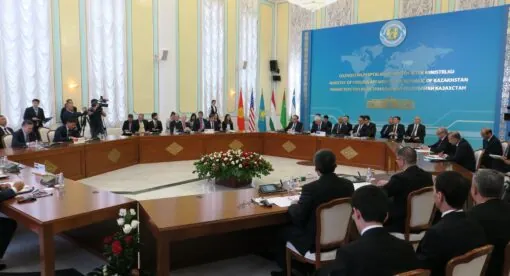The attempted assassination of former President Donald Trump and Vice President Kamala Harris’ rise to the top of the Democratic presidential ticket were seismic political events likely to significantly affect both the U.S. political environment and the domestic violent extremist threat landscape in the runup to Election Day and perhaps beyond.
Within a wider political and threat environment characterized by the growing normalization of glorifying violence against political adversaries, plus rising instances of harassment, threats, and attempted acts of violence against political figures at the local, state, and federal levels, these events highlight security concerns surrounding high-profile political figures, particularly Trump and Harris. Emerging details from the aftermath of the Trump attack also underscore the role that tone-setting from national leaders can play in cooling passions and heading off potential retaliatory violence and suggest the growing use of uncrewed aerial systems (UAS) in future attack planning and preparation.
Attempted Assassination Against Trump and Harris Becoming the Democratic Nominee
The attack that nearly succeeded in killing Trump was widely considered an act of political violence. (Investigators have yet to uncover the shooter’s motive.) It occurred within a wider context of the heightened short-term risk of political violence and erosion of U.S. democratic foundations, identified by the authors, going into the 2024 presidential elections.
The political impact of the incident was immediate: Key political and civic figures from across the ideological spectrum simultaneously condemned the violence while also calling for restraint in public rhetoric and behavior. Notably, no known acts of political violence to date have occurred in response to the event. While there were notable exceptions, national leaders including Trump largely maintained a measured tone in regard to the attack even as the Republican candidate and his supporters gained political momentum after the attempt.
Beyond the event’s wider political repercussions, data compiled by Moonshot, a consulting firm focused on online violent extremism, indicates it significantly shifted the U.S. domestic extremist threat landscape. They found dramatic increases of rhetoric supporting violence within domestic extremist online spaces one week after the attack, including:
- “100% increase in threats and encouragement to violence
- “633% increase in calls for a civil war”
- “445% increase in threats of violence toward politicians”
However, in their analysis, Moonshot pointed out that despite the uptick in violent and violence-supporting (i.e., condoning) rhetoric, the incident “has not prompted as violent of a response as other major events.” For example, the firm noted that the FBI’s execution of an August 2022 search warrant at Trump’s Mar-a-Lago residence “prompted an online response approximately five times more violent and hostile than the attempted assassination.” The difference in online reactions is explained in significant part by how national leaders reacted to each event. Whereas the Mar-a-Lago raid was characterized by hyperbolic partisanship, including from Trump, post-assassination reactions were marked by cross-partisan condemnation of the incident and restrained rhetoric and calls for national unity.
Days after the attempted assassination, President Joe Biden announced his withdrawal from the race, leaving Harris as the presumptive Democratic Party nominee. The decision energized supporters on the wider political left and intensified the perceived and real competitiveness of the contest. Her position at the top of the ticket has led to escalating rhetorical attacks against her, much of it containing sexist, antisemitic, and racist tones in both coded and overt language. The erosion of national messaging of restraint and unity that emerged after the assassination attempt has once again elevated the short-term risk of political violence. It has also raised Harris’ threat profile to would-be ideologically motivated attackers.
What’s Ahead
Preceding and immediately following Election Day, both Trump and Harris will remain symbolically attractive targets to would-be attackers with various motives, including ideologically based ones. While Trump remains a lightning rod in U.S. politics – a hero-like figure for many on the wider political right and a dangerous, anti-democratic authoritarian for those on the wider political left – his attractiveness as a target as compared to before the assassination attempt is likely to diminish for two reasons. First, security protocols are likely to be revised, tightened, and expanded to include additional personnel that will cover a wider perimeter, thus “hardening” him as a potential target. Second, irrespective of the attacker’s motive, a strong cross-partisan consensus quickly developed to condemn the attack, further reducing wider socio-political incentives for ideologically motivated actors to commit acts of political violence, including another assassination attempt. While such acts of political violence are often carried out by individuals on the ideological fringes of society, they are nevertheless influenced by the tone of public discourse, especially if they perceive national leaders to be legitimizing their views. Nevertheless, additional assassination attempts cannot be completely ruled out, either.
In addition to the failed attack and favorable political momentum for Trump at the time, vocal consensus for national unity and restraint that immediately followed are judged to be key factors that halted any movement toward immediate retaliatory violence, as well as actors in the “aspirational” phase of attack planning (i.e., those who have the intent to attack but have not taken concrete steps toward executing one). However, those factors have not halted the operational tempo of some actors already engaged in planning and preparation of violent acts. Given the likely shift in tone from the united condemnation of the Trump assassination attempt with Harris now the Democratic presidential nominee, the likelihood of planned acts of political violence by lone actors and small groups will increase in the months ahead. This is due to the widely held perception that the presidential race became much more competitive, thereby incentivizing stakeholders across the political spectrum to use increasingly heated rhetoric. We anticipate this shift will largely occur along partisan lines. Whereas opinion shapers on the wider political left will likely remain largely committed to maintaining more restrained rhetoric, we anticipate there will be less message discipline on the wider political right, in significant part due to Trump’s inflammatory and improvisational style of politics.
We anticipate that Harris may face high levels of verbal and planned physical threats of violence. As vice president, Harris already has been the target of death threats, leading to the prosecution of at least two individuals. On Jan. 6, 2021, Harris, then the vice president-elect, had walked within feet of an operationally viable pipe bomb planted at the Democratic National Committee headquarters that could have killed her, a report by the inspector general of the Department of Homeland Security (DHS) noted.
Harris is likely to face a level of threat similar to that experienced by former President Barack Obama from the wider political right during the 2008 presidential contest and his subsequent victory. Obama, the first U.S. president of African-American background, faced a racially motivated backlash among wide segments of the political right. This included armed mobilization, threats, and attempted acts of violence among far-right extremists, a situation that a 2009 intelligence analysis by DHS had accurately forecast. During this time, Obama faced a 400% increase in threats compared to his predecessor, largely inspired by racist and other politically motivated sentiments from far-right white supremacist and antigovernment extremists.
However, officials with experience protecting U.S. presidents, such as former U.S. Secret Service agent Jeff James, note that in addition to her racial background, Harris has other factors that could further inspire both rhetorical and physical attacks, including her sex, her marriage to a Jewish man, and her status as an ardent advocate of reproductive rights, including abortion. It is likely these factors will inspire increasing sexist and racist rhetoric against Harris, fueling a perception by violent extremists as a permissive environment to plan and attempt physical attacks against her. Therefore, this opens the possibility that, in addition to white supremacists and antigovernment extremists, far-right male supremacists such as antiabortion extremists and misogynist involuntary celibates (“incels”) may also include her as a target. Her decision to tap Minnesota Gov. Tim Walz, a politician with a strong record of defending LGBTQ+ rights and abortion access, potentially adds to her threat profile from male supremacists and other far-right extremists who have made issues of gender and sexuality an increasingly central part of their recent armed mobilization, including violence.
Outside of the risk of violence targeting the two leading presidential candidates, politicians across the political spectrum at local, state, and federal levels will continue to face high levels of threats and potential violence.
The attempted assassination of Trump also underscores the growing use of UAS, or “aerial drones,” in the operational planning of high-profile attackers. The FBI revealed that Trump’s would-be assassin had flown a drone over the rally site two hours before Trump was scheduled to speak as part of the reconnaissance and surveillance phases of his attack planning. We judge future use of UAS assets in attack planning to be high, largely due to the ease of access to commercially available technology, user friendliness of UAS platforms, and their demonstrated utility for such purposes. The potential of UAS as a weapons delivery system to execute a physical attack cannot be ruled out.
Beyond Security Threats
Finally, beyond the risk of targeted violence, recent developments also have important potential impacts on the wider political environment. On the political right, mis/disinformation and conspiracy theories are likely to continue enjoying a strong degree of mainstream acceptance. The three most salient conspiracy theories identified in the authors’ strategic estimate – “Stop the Steal,” QAnon, and “Great Replacement” – are expected to continue their convergence. Conspiracy theory dissemination and buy-in among target audiences will likely intensify if Trump loses or is expected to lose in the run-up to what is widely expected to be a hotly contested election and therefore increase the likelihood of social unrest.
Further, Christian nationalism is expected to continue playing a central role on the political right as both an umbrella ideology and a political movement, particularly in the wake of the assassination attempt’s failure, which many followers view as a sign of divine intervention. These developments are also important to the U.S. domestic threat landscape as conspiracy theories and ideologies have provided the inspiration for armed mobilization and numerous acts of political violence, including the Jan. 6, 2021, insurrection at the U.S. Capitol complex. at the U.S. Capitol complex.
Holding other variables constant, we expect supporters of the wider political left to maintain a high degree of energy and momentum going into Election Day. A corollary to this trend is growing internal cohesiveness. Relative to Biden, Harris has publicly expressed greater concerns about humanitarian conditions in the Gaza Strip and, according to news reports, “has been a forceful and early advocate for a cease-fire and for putting more pressure on Israel over humanitarian conditions in Gaza.” While this issue has led to rifts across the political spectrum, internal divisiveness has been especially pronounced on the political left and led to left-wing pro-Palestinian actors withdrawing their support for Biden’s campaign. This is especially important in key battleground states such as Michigan, Pennsylvania, and Georgia that have large numbers of politically active Black, Muslim, and Middle Eastern communities that are largely sympathetic to the plight of Palestinians. At the same time, in a political balancing act toward other Democratic Party constituencies, both Harris and her husband, Doug Emhoff, have been important influences in developing White House policy to combat antisemitism and maintain a broadly pro-Israel stance. While Harris will need to walk a political tightrope on this issue, her stance opens the strong possibility of ameliorating internal rifts, at least temporarily, over moral concerns associated with the Israel-Gaza conflict.
While it may encourage some pro-Palestinian actors to support Harris’ campaign, others are not likely to be persuaded, particularly in light of recent killings of Hamas and Hezbollah officials, as well as the absence of any major policy changes, that are unlikely to occur in the short-term. Thus, holding all other variables constant (including no cease-fire agreement between Israel and Hamas), significant disruptions, including possible acts of violence, could be expected in and around the Democratic National Convention. Further threats and acts of harassment and violence directed at political candidates are also anticipated in the run-up to Election Day and beyond, if all other variables hold constant.
Conclusion
In a joint threat assessment released in the immediate aftermath of the attempted assassination of Trump, the FBI and DHS warn that violent extremists could try to attack political events over the next few months. “The FBI and DHS remain concerned … particularly given that individuals in some online communities have threatened, encouraged, or referenced acts of violence in response to the attempted assassination,” the bulletin stated.
Harris’ rise to the top of the Democratic ticket has increased the presidential election’s competitiveness and increased her risk of attack. As a multiracial woman running for the White House, she is likely to face a social backlash paralleling Obama’s experience, including threats and assassination plots. Further elevating her risk is the fact that she’s a woman, has a Jewish spouse, and has a political identity as a Democrat ardently supporting reproductive rights. Thus, in addition to threats from such expected sources as white supremacists and antigovernment extremists, Harris faces the added risk of threats by other far-right actors like male supremacists.
Finally, recent developments also display signs of a significant impact on the wider political landscape. The growth and convergence of key conspiracy theories and ideologies on the wider political right, including the far right, in the wake of the assassination attempt increase the likelihood of social unrest in the event Trump loses the election. Meantime, Harris’ emergence as the Democratic Party presidential candidate has the potential to ameliorate rifts on the wider political left regarding Gaza. However, while she may be able to win over some pro-Palestinian activists without losing significant support from pro-Israel supporters, it may not be enough to win over hard-line far leftists. These developments in turn contribute further complexity to the threat landscape, as the underlying belief sets and grievances of both right-wing and left-wing actors are likely to remain undiminished.
In other words, the run-up to the 2024 presidential election poses a particularly volatile and dangerous risk of political violence and threat to democratic stability in the U.S. The immediate implications of the attempted Trump assassination and Harris’ anointment as Democratic Party nominee for the domestic political and violent extremist threat landscape will carry into Election Day and beyond.
Alejandro J. Beutel is a Non-Resident Fellow at the New Lines Institute, specializing in the study and analysis of violent and non-violent Islamist and far-right movements. He is also a Research Affiliate at the National Consortium for the Study of Terrorism and Responses to Terrorism (START). Beutel graduated from the University of Maryland, College Park in 2013 with a Master of Public Policy. He also has a Bachelor of Science in International Relations and Diplomacy from Seton Hall University in South Orange, NJ.
Daryl Johnson is one of the foremost experts on domestic extremist groups in the US. He is a Non-Resident Fellow at the New Lines Institute. He is currently the founder of DT Analytics, a private consulting firm for law enforcement. He is also regularly cited, featured, or quoted in media covering domestic extremist groups in the US, including the New York Times, Washington Post, Wall Street Journal, Newsweek, National Public Radio, MSNBC, CNN, and NBC Nightly News, among many others. He is the author of “Hateland: A Long, Hard Look at America’s Extremist Heart” (Prometheus Books, 2019) and “Right-Wing Resurgence: How a Domestic Terrorism Threat Is Being Ignored” (Rowman & Littlefield, 2012).
The views expressed in this article are those of the author and not an official policy or position of the New Lines Institute.







